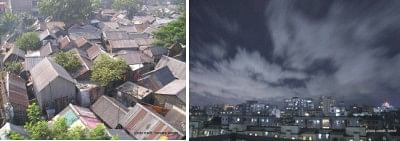Urban poverty, climate change and built environment

BANGLADESH is considered highly vulnerable climate change and climate variability. Various predictions of sea level rise puts 55% of its population on the threat of inundation. It will affect infrastructures including water systems, housing and settlements, transport networks, utilities, and industry. In recent years the recurrence of natural disasters has increased the vulnerability of the urban poor who are considered to be most affected by climate change and climate variability. The prevalence of diseases will increase their vulnerability and constrain economic activities.
Urban poverty in Bangladesh is evident in all the towns and cities. It is estimated that 43% of urban households live below the poverty line among which 23% are considered extreme poor. Around 35% of the population of six major cities live in slums which cover only 4% of their land area with limited or no access to services. Fighting poverty in urban area requires a multi faceted approach of economic, social, cultural, political as well as physical agenda. The development practitioners and designers of built environment, working to improve the condition of the urban poor, now face new challenge to accommodate issues arising from climate change and climate variability.
Designers of built environment can contribute in three areas for improving living environment for the urban poor: in building design; in settlement planning and design as well as in urban planning. Within these three areas they are to work with housing standards, environmental sustainability, economic affordability, structure as well as aesthetics for individual structures. Issues like infrastructure development, upgrading and designing community facilities affect ability of the urban poor to improve their living environment. Broader scale of urban planning, zoning and planning control may help to provide appropriate and safe locations for low-income households.
Working with urban poor needs a favourable environment created by policy orientation of the government. The policies help to ensure security of tenure, access to much needed services as well as access to finance for upgrading living environment. Governance and people's participation in the planning and implementation process can help to work for a climatic risk resilient built environment for the poor. The government's ability can be more effective by using existing social capital of the people.
There are advantages for the designers of built environment to work in Bangladesh. Bangladesh Climate Change Strategy and Action Plan 2008 reiterate Government of Bangladesh's vision to eradicate poverty and achieve economic and social well-being for all the people through a pro-poor approach prioritising adaptation and disaster risk reduction. The national building code that guides minimum standard housing requirements identifies the flexibility of compliance with all the requirements of the code.
Several NGO and donor funded projects have worked to develop infrastructure and services. These include constructing sanitary latrines, hand tube wells, paved pathways, drains and streetlights. Although the achievements are limited, but learning from such works can emphasize community initiatives to adapt cost effective locally based infrastructure development in the absence of formal provisions in the face of increasing demands from climate change.
The major challenges will be getting security of tenure for the urban poor. This will ensure access to services and infrastructure development. Climate induced hazards tend to increase in scale in absence of infrastructure. Attributes of any such incidents like the flooding of 2004 can be questioned as being not only the result of climate change but also of absence of infrastructure to cope with such scales of disaster. Furthermore it can be questioned whether is it possible for the government to acquire capacity to meet this high demand of infrastructure? Realistically; in the present situation the urban poor will continue to live in the most vulnerable lands as they can be illegally occupied, structures can be build informally with affordable materials following no 'standards' or building regulations outside official regularities.
Adaptation in built environment will have to emphasize exploring innovative measures affordable for the urban poor. Deriving a 'standard' can be an outcome of an interactive and spontaneous participatory and self mobilizing planning process. Bangladesh has experience on community based disaster management. There are enormous possibilities to explore how the built environment of the urban areas can be designed and improved to include the urban poor in city level development process. These can include how to invest in resilient infrastructure -- improving drainage, adequate disaster-safe housing, increasing access to services such as health, water and sanitation, increased security of tenure for the informal settlements etc.
Some of these issues are to be discussed in the upcoming international conference on Climate Change and Urban Poverty: Infrastructure of Development organized by the BRAC Development Institute, Department of Architecture, BRAC University with Brooks Poverty Institute of Manchester University.

 For all latest news, follow The Daily Star's Google News channel.
For all latest news, follow The Daily Star's Google News channel. 




Comments